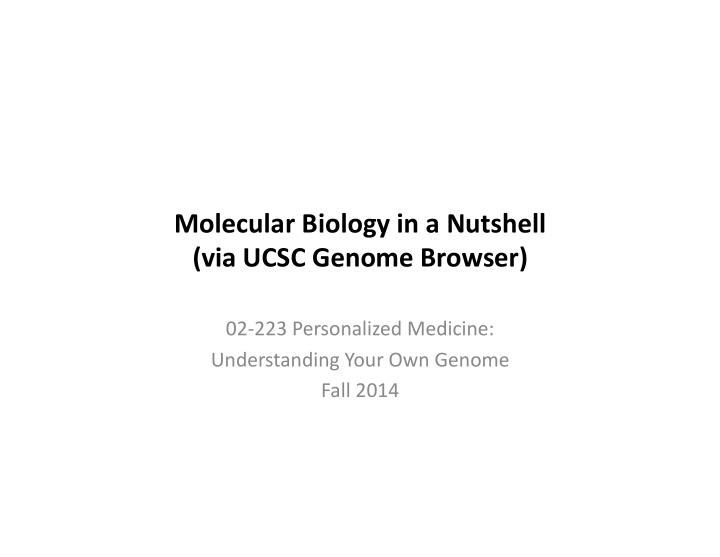



Molecular ¡Biology ¡in ¡a ¡Nutshell ¡ ¡ (via ¡UCSC ¡Genome ¡Browser) ¡ 02-‑223 ¡Personalized ¡Medicine: ¡ Understanding ¡Your ¡Own ¡Genome ¡ Fall ¡2014 ¡
DNA ¡ • Double-‑stranded ¡ helix ¡made ¡up ¡of ¡ the ¡nucleoFdes ¡A, ¡ C, ¡G, ¡and ¡T ¡ • Sugar ¡in ¡its ¡ nucleoFdes ¡is ¡ deoxyribose ¡ • NucleoFdes ¡form ¡ A–T ¡and ¡G–C ¡base ¡ pairs ¡across ¡the ¡ helix ¡
Central ¡Dogma: ¡How ¡the ¡InformaBon ¡in ¡DNA ¡is ¡ Expressed ¡ Gene ¡ DNA ¡ (Sequence ¡of ¡ A, ¡T, ¡C, ¡G’s ) ¡ TranscripFon ¡ (Sequence ¡of ¡A, ¡U, ¡C, ¡ G’s) ¡ TranslaFon ¡ Protein ¡ (Sequence ¡of ¡amino ¡ acids ) ¡ Nearly ¡universal ¡ across ¡all ¡species! ¡
Genes ¡ • In ¡the ¡recent ¡human ¡Encyclopedia ¡of ¡DNA ¡elements ¡(ENCODE) ¡ project ¡ – ~20,000 ¡protein-‑coding ¡genes ¡were ¡studies, ¡which ¡covers ¡2.94% ¡of ¡the ¡ genome ¡ – Non-‑protein ¡coding ¡regions ¡of ¡the ¡genome? ¡ • >80% ¡of ¡the ¡genome ¡is ¡funcFonal ¡as ¡regulatory ¡sequences, ¡based ¡ on ¡the ¡analysis ¡of ¡ENCODE ¡data ¡ h_p://www.nature.com/encode/#/threads ¡
RNA ¡ • RNA ¡is ¡similar ¡to ¡DNA, ¡except ¡that: ¡ – it ¡is ¡usually ¡single-‑stranded ¡ ¡ – Sequence ¡of ¡A, ¡U, ¡C, ¡G ¡ • it ¡has ¡U ¡in ¡place ¡of ¡T, ¡compared ¡to ¡DNA ¡ – the ¡sugar ¡in ¡RNA ¡nucleoFdes ¡is ¡ribose ¡instead ¡of ¡deoxyribose ¡ – Protein-‑coding ¡RNA: ¡mRNA ¡ ¡ ¡ ¡ ¡ ¡Non-‑protein-‑coding ¡RNA ¡
TranscripBon ¡ ¡ • TranscripFon ¡begins ¡with ¡ binding ¡ by ¡RNA ¡ polymerase ¡at ¡a ¡ promoter ¡ region ¡of ¡DNA . ¡ • The ¡ σ ¡subunit ¡ is ¡ responsible ¡for ¡promoter ¡ recogniFon ¡(in ¡bacteria). ¡ • Once ¡iniFaFon ¡has ¡been ¡ completed ¡with ¡the ¡ synthesis ¡of ¡the ¡first ¡8–9 ¡ nucleoFdes, ¡sigma ¡( σ ) ¡ dissociates ¡and ¡elongaFon ¡ proceeds ¡with ¡the ¡core ¡ enzyme. ¡
Prokaryote ¡vs ¡Eukaryote ¡Genomes ¡ • EukaryoFc ¡mRNAs ¡require ¡processing ¡to ¡produce ¡mature ¡ mRNAs. ¡ – Introns ¡( intervening ¡sequences ) ¡are ¡regions ¡of ¡the ¡iniFal ¡RNA ¡transcript ¡ that ¡are ¡not ¡expressed ¡in ¡the ¡amino ¡acid ¡sequence ¡of ¡the ¡protein. ¡ – Introns ¡are ¡removed ¡by ¡splicing ¡and ¡the ¡ exons ¡ ( expressed ) ¡are ¡joined ¡ together ¡in ¡the ¡mature ¡mRNA. ¡ ¡ • The ¡size ¡of ¡the ¡mature ¡mRNA ¡is ¡usually ¡much ¡smaller ¡than ¡ that ¡of ¡the ¡iniFal ¡RNA. ¡ • Prokaryote ¡genomes ¡do ¡not ¡have ¡introns ¡
Splicing ¡out ¡the ¡Introns ¡
TranscripBon ¡in ¡Eukaryotes: ¡Introns ¡and ¡Exons ¡
TranscripBon ¡in ¡Eukaryotes: ¡Introns ¡and ¡Exons ¡
Transcription Has Been Visualized by Electron Microscopy ¡
Central ¡Dogma ¡
Central ¡Dogma ¡ RNA ¡derived ¡from ¡complementary ¡ bases ¡in ¡DNA ¡ In ¡mRNA, ¡ triplet ¡codons ¡specify ¡1 ¡amino ¡acid ¡
GeneBc ¡Code ¡for ¡TranslaBon ¡ • GeneFc ¡code ¡is ¡ degenerate , ¡with ¡many ¡ amino ¡acids ¡specified ¡by ¡ more ¡than ¡one ¡codon. ¡ • Only ¡tryptophan ¡and ¡ methionine ¡are ¡encoded ¡ by ¡a ¡single ¡codon. ¡ • The ¡geneFc ¡code ¡shows ¡ order ¡in ¡that ¡chemically ¡ similar ¡amino ¡acids ¡oeen ¡ share ¡one ¡or ¡two ¡middle ¡ bases ¡in ¡the ¡triplets ¡ encoding ¡them. ¡
IniBator ¡and ¡TerminaBon ¡Codons ¡ • TerminaBon ¡codons: ¡ UAG, ¡UAA, ¡and ¡UGA ¡do ¡not ¡code ¡for ¡any ¡ amino ¡acid. ¡ • IniBator ¡codon : ¡AUG ¡is ¡the ¡only ¡codon ¡to ¡encode ¡for ¡ methionine. ¡
Synonymous ¡and ¡Nonsynonymous ¡MutaBons ¡ • Synonymous ¡mutaFons: ¡mutaFons ¡that ¡does ¡not ¡cause ¡the ¡ protein ¡code ¡to ¡change ¡ • Nonsynonymous ¡mutaFons: ¡mutaFons ¡that ¡cause ¡the ¡protein ¡ code ¡to ¡change ¡
Summary ¡ • Central ¡dogma ¡ – TranscripFon ¡of ¡DNA ¡to ¡mRNA ¡ – TranslaFon ¡of ¡mRNA ¡to ¡proteins ¡ • Introns/Exons ¡in ¡eukaryote ¡genomes ¡
Recommend
More recommend